Predatory and parasitic wasps are among the most common enemies of cavity-nesting bees. Most problem species are direct parasites of bees. Using a long, stinger-like ovipositor, these wasp species pierce loose bee cells, cocoons, or unsecured nesting materials, then lay a series of eggs on the bee or bee larva. Upon hatching, the wasp larvae consume the bee.
Chalcid Wasps
Chalcid wasps are among the most destructive parasites of leafcutter and mason bees. This group of wasps includes both native and nonnative species, and has the potential to cause catastrophic losses.
Included in this group are several wasps in the genera Monodontomerus (M. obscurus, M. montivaga, and M. osmiae). With the exception of the latter, these species are widespread throughout North America, and all are metallic green, blue, or black, with red eyes and are 5/64 to 5/32 inch in length (~2 to 4 millimeters). Males are slightly smaller than females, and emerge slightly earlier through a single hole from the bee cocoon in which they developed.
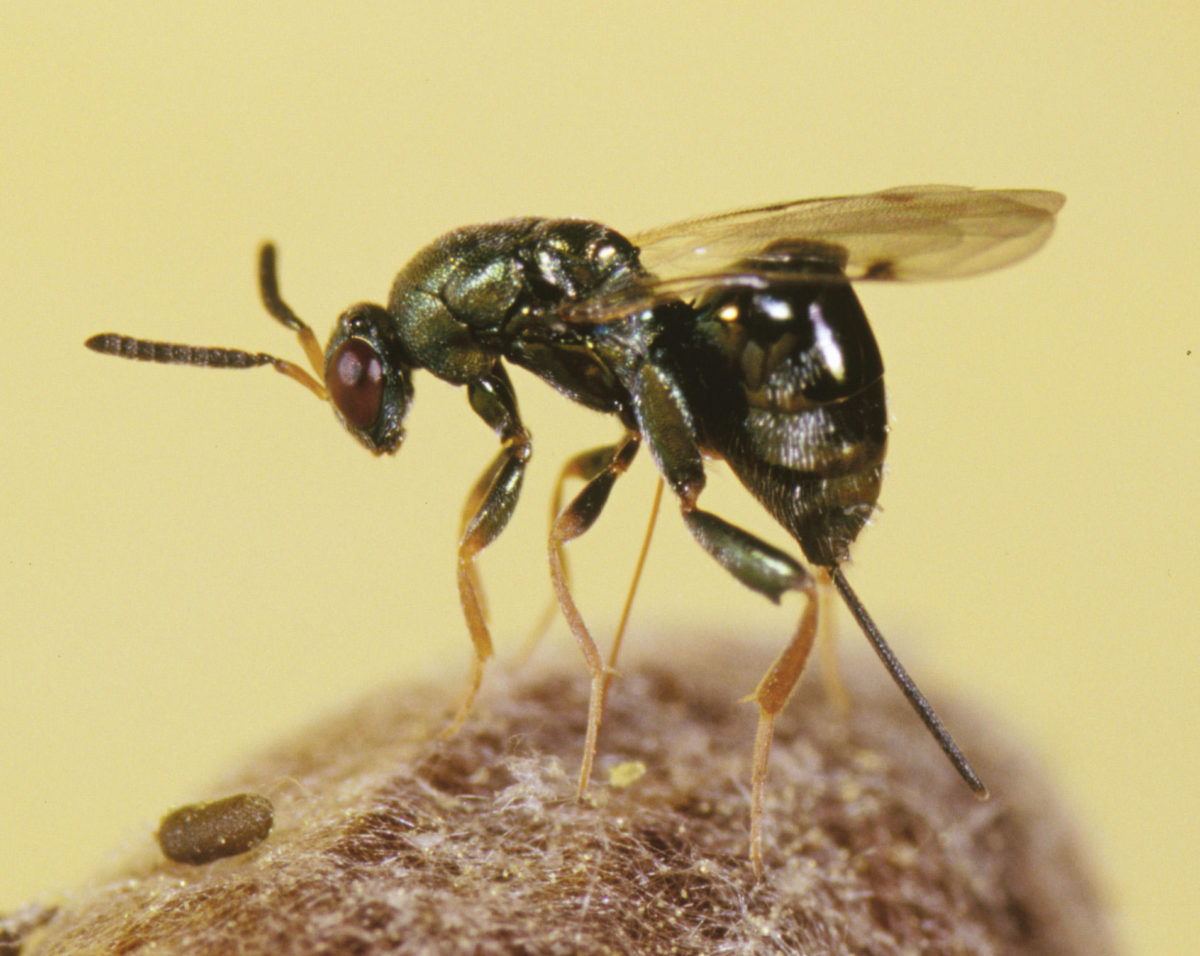
Female wasps invade nests through small crevices, or through incomplete or uncapped cells. They use their slender, stinger-like ovipositor to paralyze the bee larvae by inserting it through the wall of the cocoon (Figure A.1). In some cases they are also capable of inserting the ovipositor through thin mud or leaf cell partitions, or through thin nest materials such as paper straws or cardboard tubes less than 3/64 inch thick (~1 millimeter). They are extremely opportunistic and will invade the innermost cells of nests when possible. Unprotected loose cells are attacked mercilessly, and each female may attack multiple cells. Bees are susceptible to attack up to one day before hatching.
After paralyzing the bee larva, the female Monodontomerus lays a series of eggs (averaging 10, but up to 50) between the host larva and the inner wall of the cocoon. Upon hatching, the wasp larvae consume the bee and then pupate within the bee cocoon for up to a month. The typical sex ratio of the offspring is highly female (3:1). Because of their rapid development time and high numbers of female progeny, multiple generations can occur each season, and population growth can be explosive.
More common than Monodontomerus in many leafcutter bee operations is another chalcid wasp, Pteromalus venustus. This wasp is native to Europe and may have arrived in North America with the alfalfa leafcutter bee.
The size of P. venustus is similar to the Monodontomerus wasps with females averaging up to 7/64 inch (~2.5 millimeters) long. Females are black with dark brown legs. Males are the same, but have a metallic green head. P. venustus is believed to have a higher reproductive capacity than other chalcids, and over 100 eggs have been observed on a single bee larva— usually fewer are present however. Larvae are about 7/64 inch (~2.5 millimeters) long at maturity, white, and hairless (as opposed to Monodontomerus larvae which are covered with small bristles). Development is similar to that of Monodontomerus with larvae either progressing to adulthood, or overwintering as mature larvae. Multiple generations occur in a single season, and occasionally several generations will even occur during incubation of leafcutter bee cells resulting in high losses.
Melittobia chalybii is another chalcid wasp species, which not only parasitizes cavity-nesting bees, but many other bee and wasp species as well—including bumble bees. However, this native parasite is less common than P. venustus or Monodontomerus wasps. As with the previously discussed chalcids, the adults of this species are brown or black in color, and measure about 5/64 inch (2 millimeters) in length. A notable difference is that both winged and wingless males have been described.
Mating among M. chalybii occurs within the parasitized cocoon, where males remain. Mature larvae are about 3/64 inch (~1 millimeter) long, about half the length of mature Monodontomerus or P. venustus larvae. Egg laying and development is similar to other chalcid wasps. Multiple generations occur in a single season, with some larvae overwintering.
Unlike P. venustus, or Monodontomerus, M. chalybii gains access to host bee larvae by chewing holes through cocoons and nest partitions. Light traps are considered ineffective for the control of this parasite, and males have even been described as blind. Despite this, populations of M. chalybii are normally low in most beekeeping operations, and the parasite reportedly does not survive well under prolonged artificial cold storage conditions.
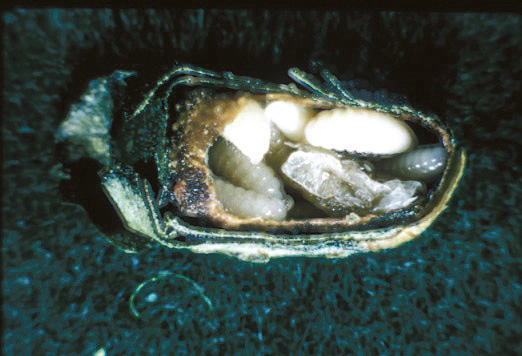
Another less common chalcid parasite is Dibrachys confusus. The size and coloration of this wasp is similar to that of P. venustus, however the legs of D. confusus are red, orange, or yellow. As with P. venustus, D. confusus emerge from a single hole in the parasitized cell (with males emerging first), then mating occurs. Ovipositing and development are similar to other chalcids. Multiple generations may occur in a single season, and the sex ratio is more male based than other chalcids (2:1). Although D. confusus has been identified as a parasite of the alfalfa leafcutter bee, it seems to be of minor importance. Higher parasitism levels occur on native leafcutter bee species, such as Megachile relativa. Its occurrence among mason bees is unknown.
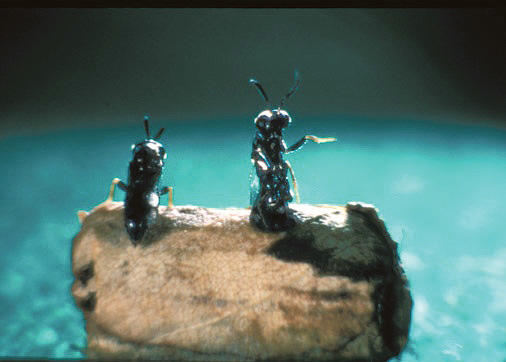
Chalcid wasps overwinter as mature larvae (Figure A.2) and emerge in leafcutter bee incubators (Figure A.3) over several days—beginning on day 9 at 86°F (30°C) and continuing until day 14 (see sidebar). Several control measures exist, but the most important practice is the use of solid nesting materials free of entry points, particularly in the rear of the nest. For this reason, drilled boards and Styrofoam nest blocks should have a tight-fitting backing material. Nests should also be removed from the field promptly after the nesting period to reduce exposure. Stored nest materials and loose cocoons can be covered with a 1-inch (2.54-centimeter) thick layer of sawdust or vermiculite (not perlite) to minimize parasite movement. Bee storage areas and incubators should be equipped with a light trap consisting of an ultraviolet black light suspended over a pan of water. Several drops of detergent should be added to the water to reduce surface tension. As wasps emerge from the nest materials, they are attracted to the light, where they fall into the water and drown. Many chalcid wasps are poor fliers, preferring to hop, so light traps should be placed on the floor of the storage area or incubator.
Nest materials and loose cocoons can also be protected by surrounding stored bees with yellow sticky cards (the kind used for monitoring crop pests), or with a fine mesh screen, or even several layers of pantyhose. Care should be taken so that contaminated materials are not confined with clean materials. Vacuuming the storage area walls and floors is also an important control tactic, especially during incubation.
Canadian leafcutter producers control chalcid wasps with dichlorvos resin pest strips (such as VaponaTM) during bee incubation. This treatment is applied from days 9 to 12 of the incubation process, after which the incubator is ventilated to remove all remaining vapor. Dichlorvos is not labeled for this purpose in the US, and improper use can result in high bee mortality. It is not recommended.
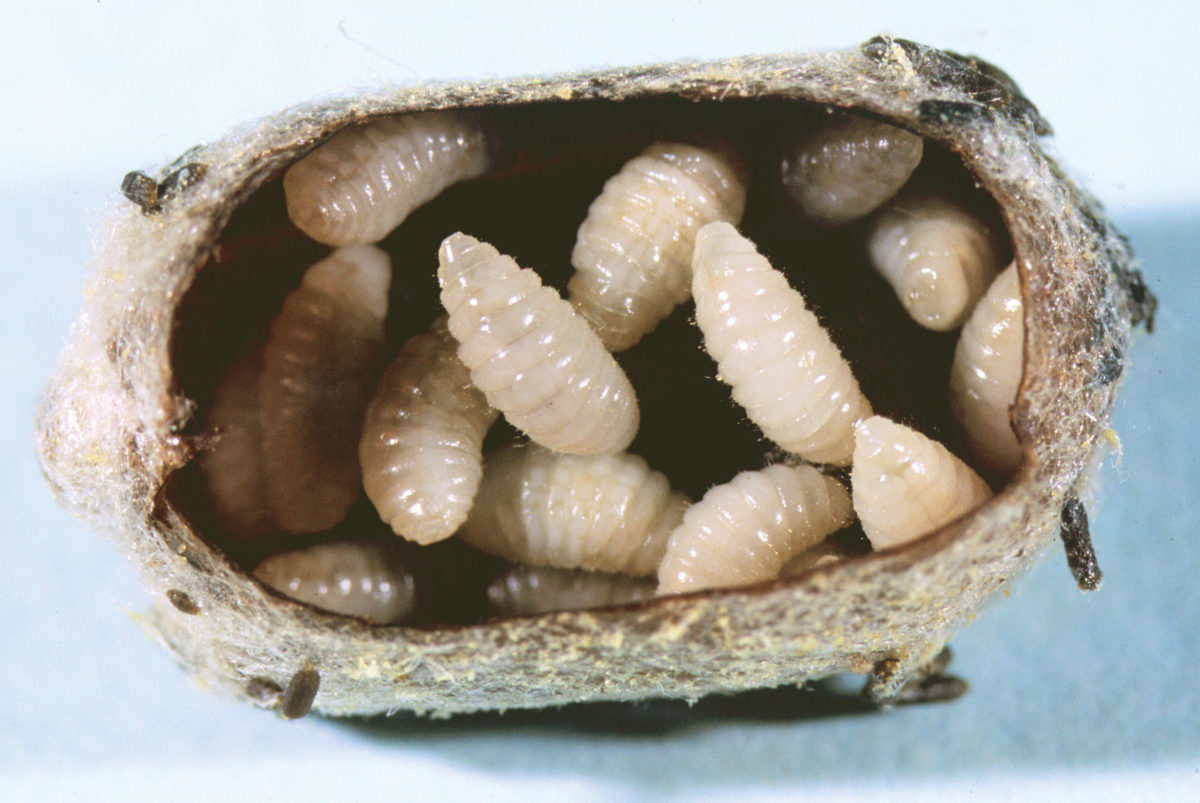
Finally, small batches of mason bee cocoons can be hand sorted to remove chalcid wasps. Parasitized cocoons are often less firm than normal cocoons and appear almost empty when squeezed lightly (Figure A.4). Questionable cocoons can be segregated and held in a transparent plastic container with a tight fitting lid. The container can then be checked several times a day and emerging wasps discarded.
Among the largest chalcid wasp parasites is Leucospis affinis, a native species measuring up to almost 1⁄2 inch in length (12.7 millimeters). This species is readily identified by its distinct black and yellow color pattern, and is easily spotted around field shelters and nest blocks where it parasitizes both leafcutter and mason bees. L. affinis parasitizes the prepupal stages of its host and has an extremely long ovipositor (normally folded over the abdomen) capable of piercing wood up to 3⁄4 inch or 19 millimeters (Figure A.5). Because of this, paper, cardboard, and Styrofoam nest materials are easily attacked—as are drilled wooden blocks with nest tunnels located near the edge of the block. A single generation occurs per year, with a single wasp developing per cell (which overwinters as a prepupa).
Aside from promptly removing and securely storing nest materials at the end of the season, few control measures exist for L. affinis. Loose-cell management does not provide effective control in many instances because wasp prepupae remain enclosed within the host cocoon, making identification and physical separation difficult. Fortunately the low reproductive rate of this parasite prevents it from becoming problematic in most instances.
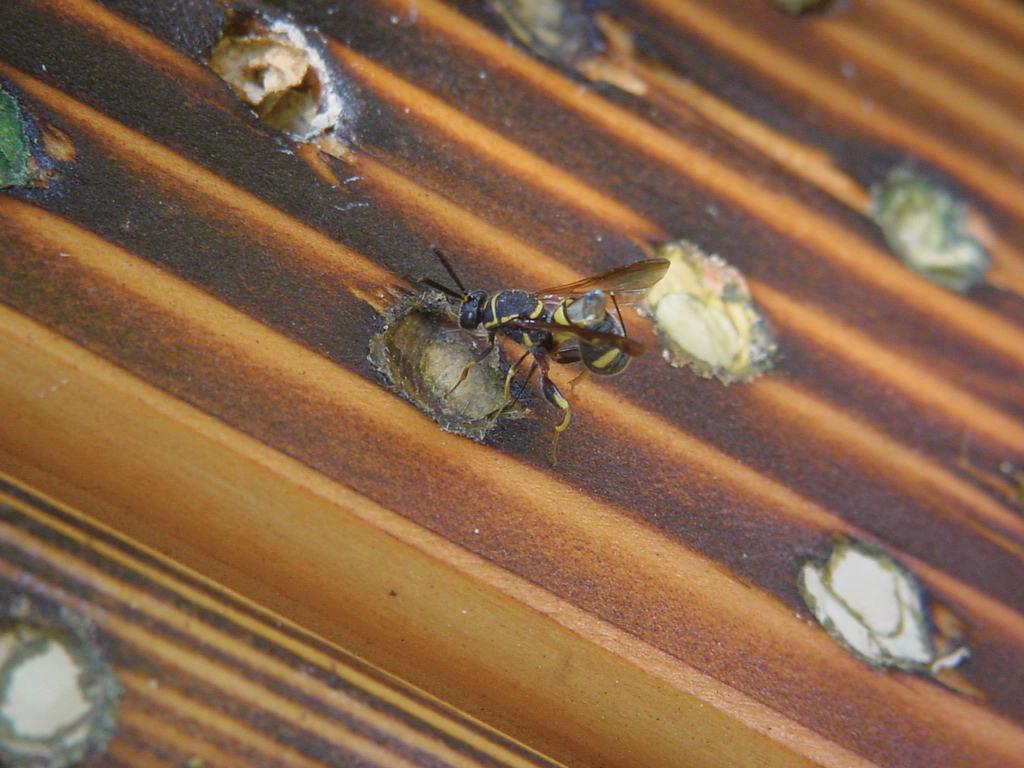
Various other chalcid wasp parasites of cavitynesting bees, such as Tetrastichus megachilids, exist, but few of these lesser-known species are commonly encountered in populations of managed bees.
Sapygid Wasps
Sapygid wasps are cleptoparasites of both leafcutter and mason bees. Cleptoparasitic insects do not directly prey upon their host species, but rather consume the food provision of the host, killing it in the process. A number of these sapygid species are associated with solitary bees, including Sapyga martini, S. centrata, and S. pumila. Adults are typically black and yellow and measure up to about 1⁄2 inch long (12.7 millimeters).
Sapygid wasps lay their eggs in the nests of bees while the female bee is away foraging. Several eggs may be laid, although only one offspring develops. This offspring kills the developing bee and any sapygid siblings, and then feeds on the pollen-nectar provision. The larva undergoes several growth stages before spinning a cocoon and pupating. The wasp then overwinters as an adult, with a single generation per year.
S. pumila is commonly associated with leafcutter bees in some areas, and has been found to spend the night inside the holes of bee nest blocks. However, when available, S. pumila prefers smaller holes, 3/32 inch (~2.5 millimeter) in diameter, and various traps have been devised to take advantage of that habit. These “night station traps” often consist of a section of PVC pipe, closed on both ends and drilled with a series of 3/32-inch holes. Within the pipe section, a length of flypaper, pesticide-impregnated cardboard, or a strip of sticky cardboard (such as yellow sticky cards used for monitoring crop pests), is inserted. Alternate sapygid trap designs have been developed, consisting of black-light attractants with a series of passageways that separate insects by size—drowning the smaller sapygids in a pan of oil, and allowing the larger bees to escape. Such traps are not in widespread use however.
Chrysidid Wasps
A number of chrysidid wasps prey upon solitary bees; these include Chrysura smaragdicolor and C. pacifica in the western, and C. kyae in the eastern states. All are minor native predators measuring up to about 1⁄2 inch in length (12.7 millimeters), and are typically metallic green in color (Figure A.6).
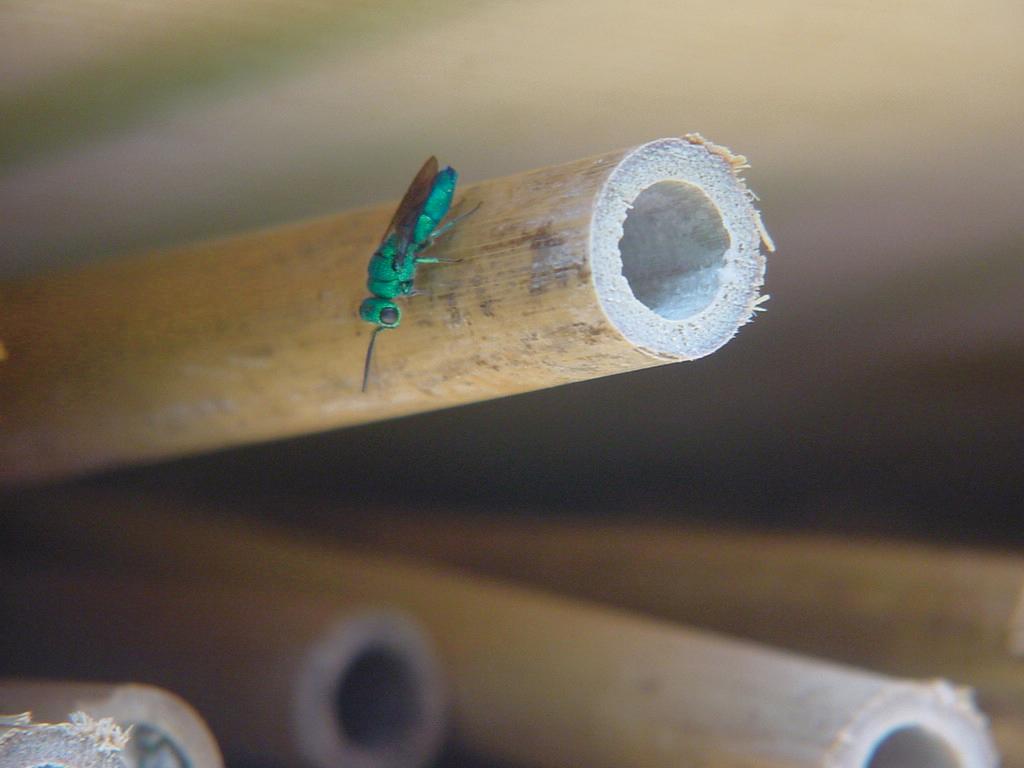
Female chysidids lay their eggs in unattended bee nests (while the female bee is away). Upon hatching, the wasp larva attaches itself to the host larva which it later consumes. After feeding, the wasp larva then spins a thin, semi-transparent cocoon before overwintering. Chrysura wasps overwinter as adults, and there is one generation a year.
Ichneumon Wasps
This group of solitary wasps consists of two families, the Ichneumonidae and the Braconidae. Together they comprise nearly 100,000 diverse species worldwide, ranging in size from 1⁄8 inch to over 5 inches (~3 to 130 millimeters) in length. As with other parasitic wasps, ichneumons pierce natal bee nests and lay one or more eggs on the developing bee.
The vast majority of wasps in this group do not prey upon bees, but instead are beneficial biological controls of many pest insects. However, the large size of some ichneumons, along with their occasionally alarming appearance (with some individuals bearing ovipositors over an inch in length), can cause concern when they are observed ovipositing into sealed bee nests.
Normally control can be achieved simply by removing nests from the field promptly after they are filled and storing them in a secure indoor location. Styrofoam leafcutter nests tend to be the most easily attacked by these wasps, though many species can oviposit through solid wood.
Other Predatory Wasps
Large Vespid wasps such as the German yellowjacket (Vespula germanica), the bald-faced hornet (Dolichovespula maculate), and paper wasps (in the genus Polistes), are occasional minor predators of managed bees. These wasps form conspicuous paper nests and live together in social units much like ants or honey bees.
Adult wasps feed on carbohydrate sources such as flower nectar, and prey upon insects as a protein source for their developing offspring. Usually no control is necessary. However, occasionally these wasps may construct hives near mason bee nests, or even within leafcutter bee shelters. In these cases predation levels may be high.
Routine inspection of bee shelters should be performed, and wasp nests should be removed as necessary. Pesticide use should be avoided so as to avoid bee poisoning. Protective clothing, including a honey beekeeper’s veil and gloves should be worn when removing wasp nests. Occasionally wasps will attempt to rebuild new nests in place of the removed one, so follow-up inspections are necessary.
